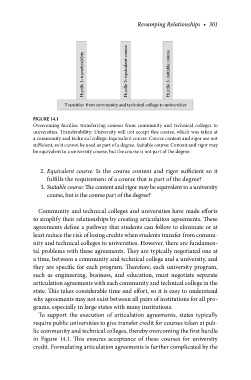Page 331 - Crisis in Higher Education
P. 331
Revamping Relationships • 301
Hurdle 1: transferability Hurdle 2: equivalent course Hurdle 3: suitable course
Transition from community and technical college to universities
FIGURE 14.1
Overcoming hurdles: transferring courses from community and technical colleges to
universities. Transferability: University will not accept this course, which was taken at
a community and technical college. Equivalent course: Course content and rigor are not
sufficient, so it cannot be used as part of a degree. Suitable course: Content and rigor may
be equivalent to a university course, but the course is not part of the degree.
2. Equivalent course: Is the course content and rigor sufficient so it
fulfills the requirement of a course that is part of the degree?
3. Suitable course: The content and rigor may be equivalent to a university
course, but is the course part of the degree?
Community and technical colleges and universities have made efforts
to simplify their relationships by creating articulation agreements. These
agreements define a pathway that students can follow to eliminate or at
least reduce the risk of losing credits when students transfer from commu-
nity and technical colleges to universities. However, there are fundamen-
tal problems with these agreements. They are typically negotiated one at
a time, between a community and technical college and a university, and
they are specific for each program. Therefore, each university program,
such as engineering, business, and education, must negotiate separate
articulation agreements with each community and technical college in the
state. This takes considerable time and effort, so it is easy to understand
why agreements may not exist between all pairs of institutions for all pro-
grams, especially in large states with many institutions.
To support the execution of articulation agreements, states typically
require public universities to give transfer credit for courses taken at pub-
lic community and technical colleges, thereby overcoming the first hurdle
in Figure 14.1. This ensures acceptance of these courses for university
credit. Formulating articulation agreements is further complicated by the

